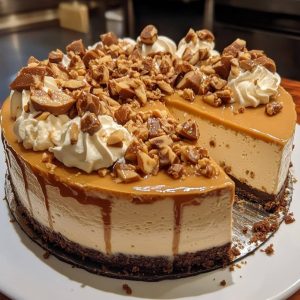Graham Crackers: For the crumbs, you’ll need approximately 15 full sheet graham crackers. If preferred, you can also use vanilla wafer crumbs as an alternative.
Flour: If you're looking for a gluten-free option, cornstarch can be used instead of flour. Just use half the amount called for.
Cream Cheese: Be sure to use brick-style, full-fat cream cheese. Avoid the tubs, low-fat, or whipped varieties as they don’t work as well.
Pudding Mix: Both instant or cook n' serve pudding mixes can be used. However, keep in mind that instant pudding thickens more quickly, which will result in a thicker filling.
Refrigerator Storage: If you have leftover cheesecake, store it in an airtight cake carrier or wrap it in plastic wrap. You can use toothpicks to create a small gap between the plastic wrap and the topping to prevent it from sticking. For sliced cheesecake, arrange the pieces in a single layer in an airtight container. This cheesecake is best when eaten within 4-5 days.
Freezer: Before freezing, let the cheesecake firm up in the freezer for a couple of hours. Then wrap it in a double layer of plastic wrap. Alternatively, you can freeze individual slices in a single layer in an airtight container. The cheesecake can be stored in the freezer for up to 3 months. When ready to serve, thaw it in the fridge. If you're prepping ahead, it’s better to freeze the cheesecake without the topping, as the apple topping may not look as fresh after being frozen.
Flour: If you're looking for a gluten-free option, cornstarch can be used instead of flour. Just use half the amount called for.
Cream Cheese: Be sure to use brick-style, full-fat cream cheese. Avoid the tubs, low-fat, or whipped varieties as they don’t work as well.
Pudding Mix: Both instant or cook n' serve pudding mixes can be used. However, keep in mind that instant pudding thickens more quickly, which will result in a thicker filling.
Refrigerator Storage: If you have leftover cheesecake, store it in an airtight cake carrier or wrap it in plastic wrap. You can use toothpicks to create a small gap between the plastic wrap and the topping to prevent it from sticking. For sliced cheesecake, arrange the pieces in a single layer in an airtight container. This cheesecake is best when eaten within 4-5 days.
Freezer: Before freezing, let the cheesecake firm up in the freezer for a couple of hours. Then wrap it in a double layer of plastic wrap. Alternatively, you can freeze individual slices in a single layer in an airtight container. The cheesecake can be stored in the freezer for up to 3 months. When ready to serve, thaw it in the fridge. If you're prepping ahead, it’s better to freeze the cheesecake without the topping, as the apple topping may not look as fresh after being frozen.
